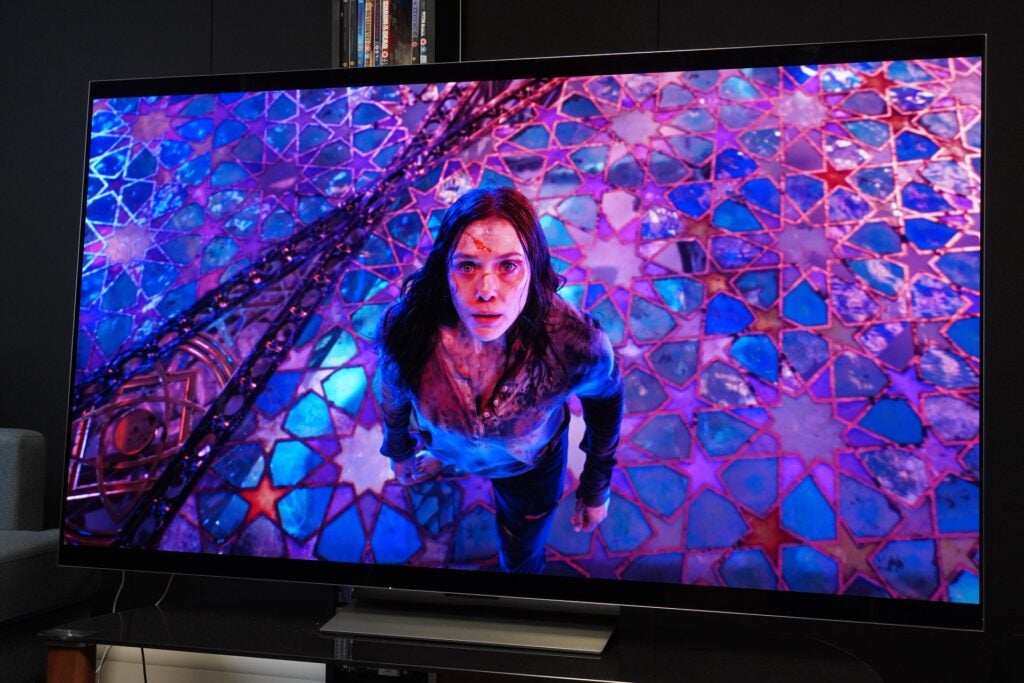What’s the difference between OLED and QLED? We delve into the particularities of these two TV displays.
Televisions have never been better, or more exciting, than they are today. This is partly because manufacturers have gone into competitive hyperdrive in producing high brightness panels with tones of features.
OLED and QLED are two such displays, and have been battling for many years for consumer supremacy. Both make their pictures in very different ways, and both come with quite distinct advantages and disadvantages.
How OLED works


OLED screens enable every pixel they contain to produce its own light. The clue to how they achieve this is in the technology’s full name: Organic Light Emitting Diode.
Each pixel is made from organic materials that light up when charged with electricity. The more electricity you apply to these organic materials, the brighter they’ll glow, with different materials used to deliver different colours.
Since each OLED pixel needs its own electric current to work, you end up with a situation where every single pixel works independently of its neighbours. This sort of pixel-level lighting precision has made the technology a firm favourite of home cinema fans over recent years.
How QLED works


QLED is basically a fancy take on LCD TVs and refers to any TV that combines traditional LCD technology with Quantum Dots.
Quantum Dots are an alternative to the filters LCD TVs usually employ to make colour. They use an array of tiny dots of slightly different sizes that produce different wavelengths (and therefore colours) when light is applied to them.
Since each tiny ‘dot’ is focused on just one colour, Quantum Dots can produce bolder, but also more precise colours than you’d get from traditional filters. They can also make more efficient use of any light that hits them than a typical filter, yielding potential energy consumption advantages.
OLED advantages
Peerless black-level performance
Since every pixel in an OLED TV can make its own light, it’s possible to have a perfectly black pixel sitting right alongside a maximum-brightness white pixel.
This individual pixel-level light control delivers more contrast and image light uniformity than any current LED solution on the market.
This comes into its own with HDR, as HDR’s brighter image highlights can be delivered without compromising the dark areas around them. There’s none of the general greying over of dark elements, or distracting blooming or striping around bright elements you get with LED TVs (depending on the type of backlighting they use).


Beautiful contrast
Being able to put deep black and bright white pixels beside each other without compromise has a stunning effect on a picture’s contrast. Torches flickering in a dark window, the moon in a night sky, stars in space, spotlights in dark buildings – all such picture elements enjoy a level of intensity on OLED screens that aren’t matched by the picture performance on any other current screen technology.
So pronounced can the difference in brightness be between the darkest and brightest parts of an OLED screen’s images, in fact, that very extreme contrast content can actually momentarily make OLED appear brighter than QLED.
Enhanced shadow detail
Being able to control the light level of every pixel enables OLED TVs to reveal subtle shades and details in the darkest corners of pictures that can get ‘crushed’ out of QLED pictures.
This doesn’t always work out as you’d expect. Certainly many OLED TVs need quite carefully setting up to avoid crushing subtle detailing themselves. But the principle is sound, and borne out in our head-to-head comparisons of real-world TVs.


Superior viewing angles
Since OLED TVs use self-emissive pixels, their pictures can be viewed from a much wider angle than those of QLED TVs before they start losing any significant colour and contrast. This is clearly a big deal if your viewing room requires anyone to sit off down near the sides of the screen.
Unlocks the dark end of what HDR can do
While some refer to the introduction of HDR as creating a brightness race where TVs are concerned, the reality is HDR is as much about the dark end of the light spectrum as the bright end.
So while QLED can certainly put on a light show with HDR’s bright stuff, OLED is better equipped to unlock all that extended dark scene detail HDR can carry.


QLED advantages
Really bright
For decades, brightness wasn’t really a big deal in the TV world. The old ‘Rec. 709’ video standard just didn’t put much store in it. The arrival of HDR video, though, has suddenly put brightness on the TV map.
The Samsung Q80D manages to hit just 1000 nits on both a 10% and 25% HDR test window, and while this isn’t as bright as more premium LCD TVs, at the time of review it was available for less than a £100.
While OLEDs regularly push past the barrier of 1000 nits, you’ll have to pay more for that level of brightness.


More colour volume
Colour volume is the name given to measurements of colour at varying levels of brightness. So it kind of goes without saying that since QLED TVs can hit higher brightness levels, they’re able to deliver measurably more of the sorts of colour volumes we see in the real world.
More lifelike HDR content
HDR video is currently defined as being capable of hitting peak brightness outputs of 10,000 nits. Most HDR content to date is mastered to peaks of 1000-4000 nits (or less). But this still provides plenty of breathing room for the brightness of QLED TVs to deliver much more of the sort of impact – at least during bright scenes – that HDR is designed to reproduce.
As well as delivering a bigger picture quality jump from standard dynamic range to HDR during bright scenes, this extra brightness means that QLED screens can make HDR pictures look more lifelike. After all, one of the points of HDR is to enable screens to reproduce more of the light levels our eyes witness every day.


Immune to screen burn
Since QLED TVs don’t use organic elements, they are essentially immune to screen burn/image retention, whereby prolonged exposure to a particularly bright static image element – a channel logo, say, or part of a game HUD – can eventually leave a permanent shadow of that image element behind.
OLED TVs have improved greatly in this respect, and you can mitigate the risks of screen burn by taking care how you use an OLED screen – especially in the first 100 hours of its life. But this still isn’t as good as being immune to the issue like QLED screens are.


Easier/cheaper to manufacture
OLED TVs are notoriously difficult to make, meaning that panel yields were, until recently, low. This has tended to result in prices that have remained stubbornly high. QLED technology, by comparison, can be relatively straightforward to manufacture, costing only a small premium over standard LED TVs.
It should be stressed, though, that chief OLED manufacturer LG Display has made great strides with OLED production efficiencies – and OLED prices have started to fall as a result.
Which is better?
Trying to simply pick OLED over QLED or vice versa is a fool’s errand. The bottom line is that they both excel in different ways. And so they both suit different types of viewing conditions and picture preferences.
If you’re looking for a TV for a bright room, or something to give you the most consistent dynamism from HDR content, the top-end, direct-lit QLED TVs are the way to go. They’re brighter, deliver more ‘real-world’ colour volume, handle ambient light better and are immune to screen burn issues.
For darker conditions, though – at least for the sort of AV fans who value black-level depth and dark detailing over brightness – OLED TVs are the way to go. That is particularly the case if your room layout routinely requires someone to have to watch the TV from much of an angle.



